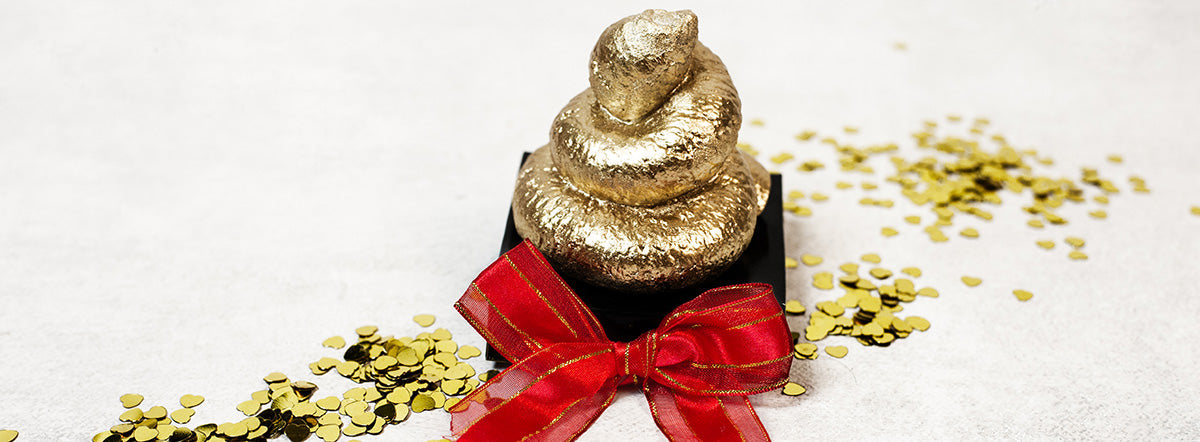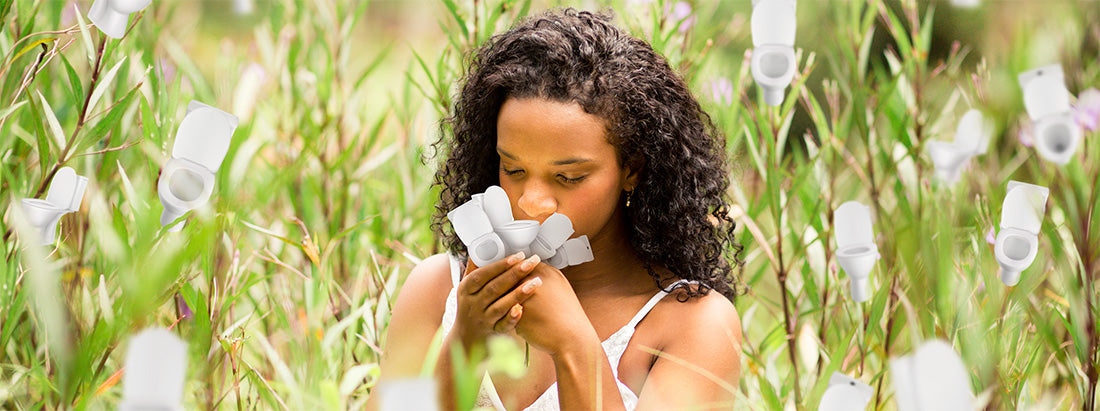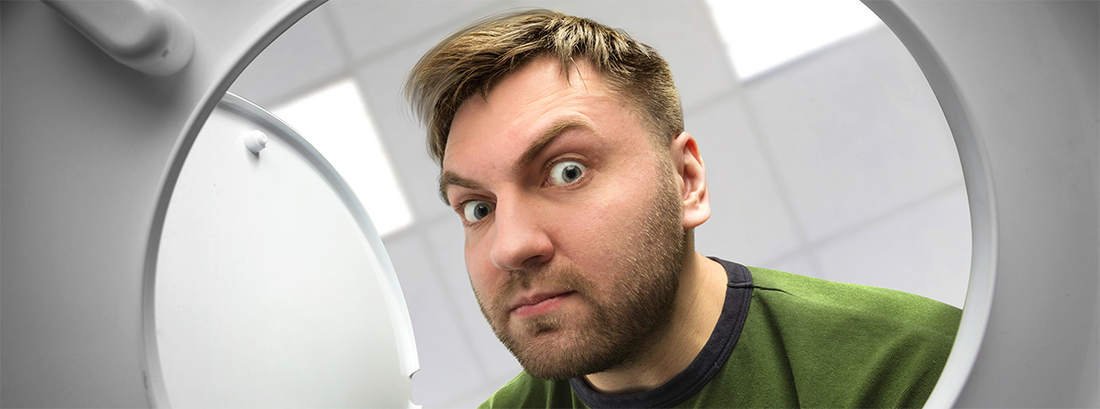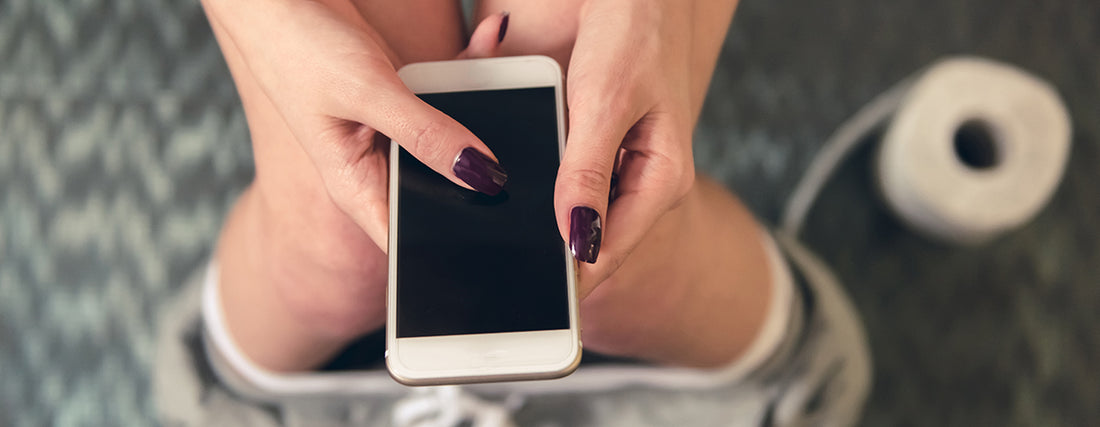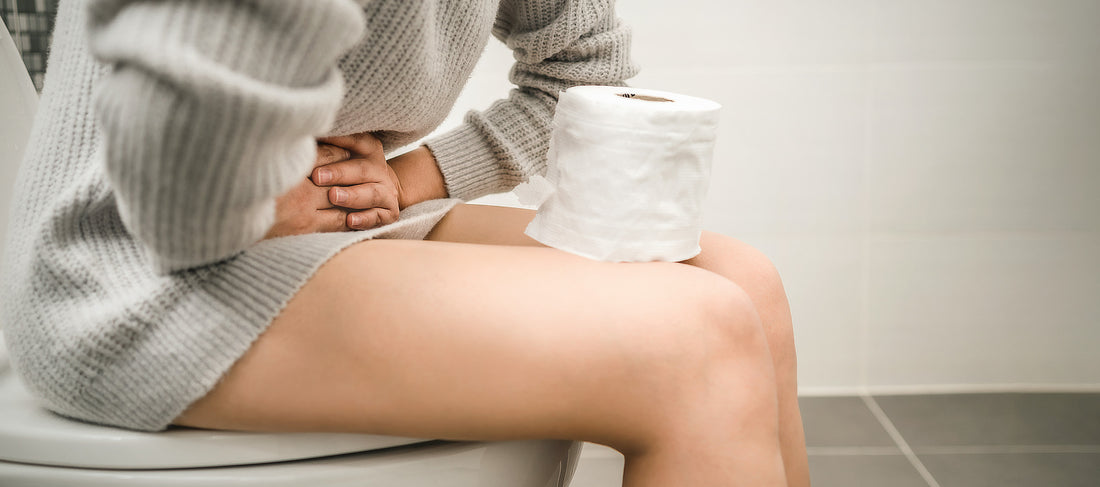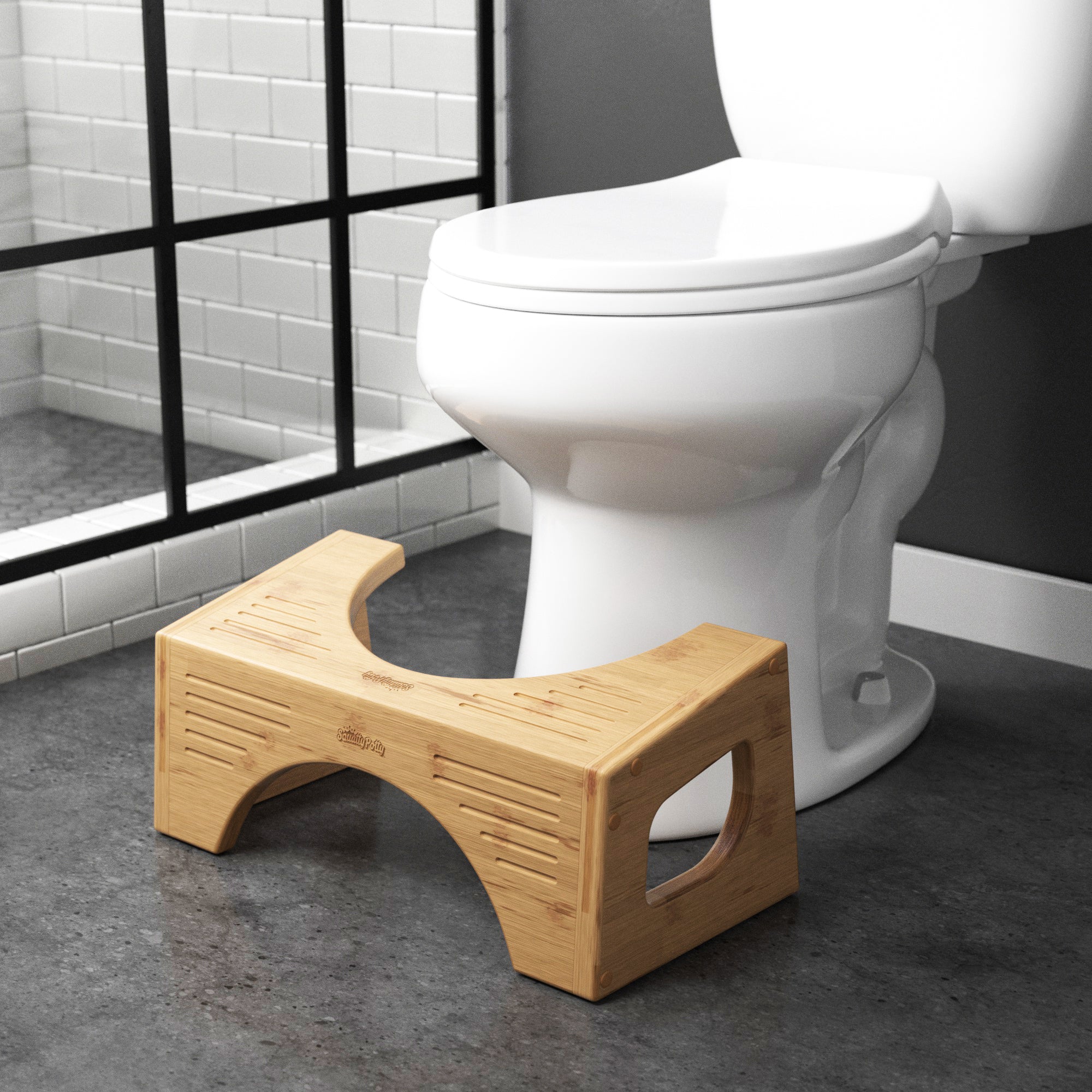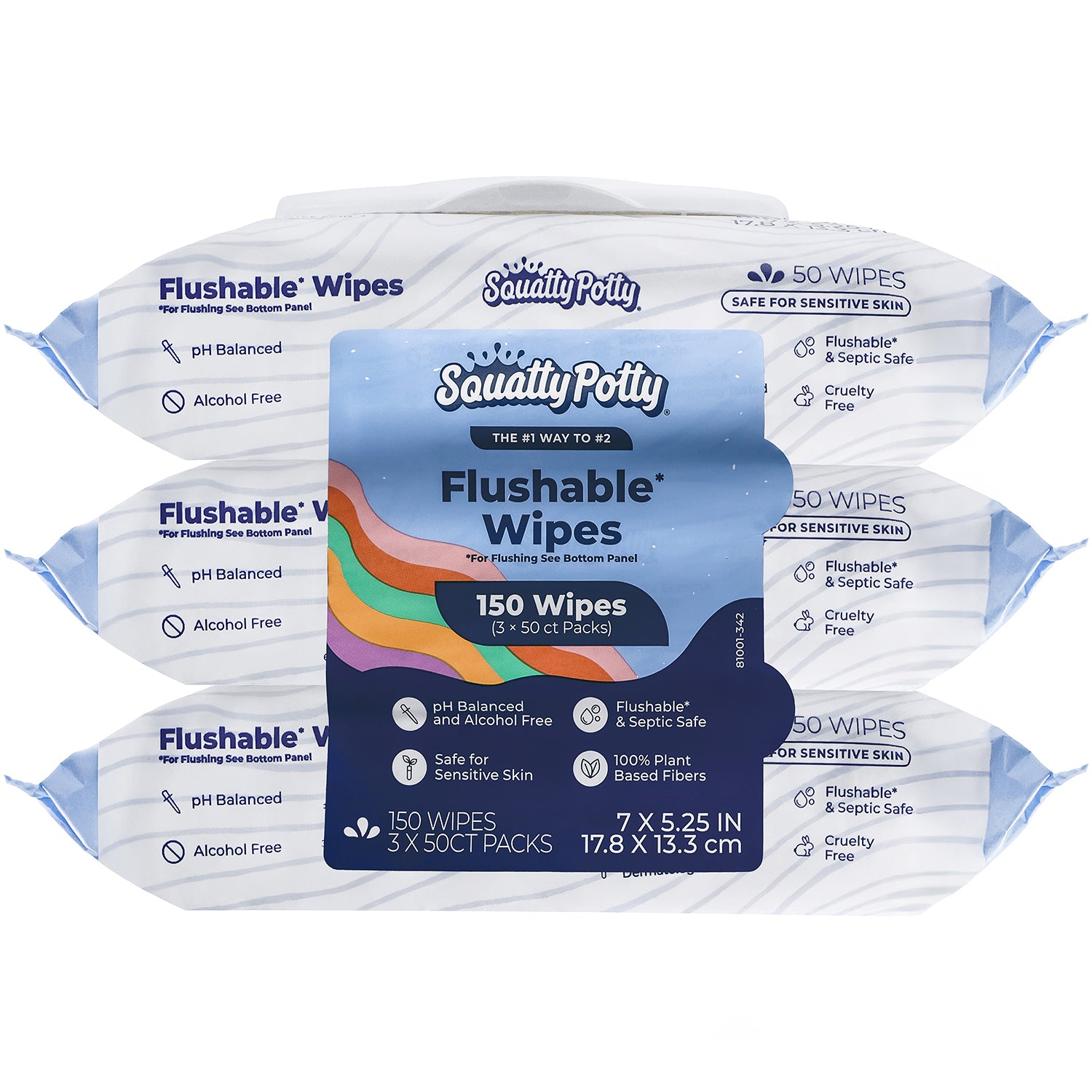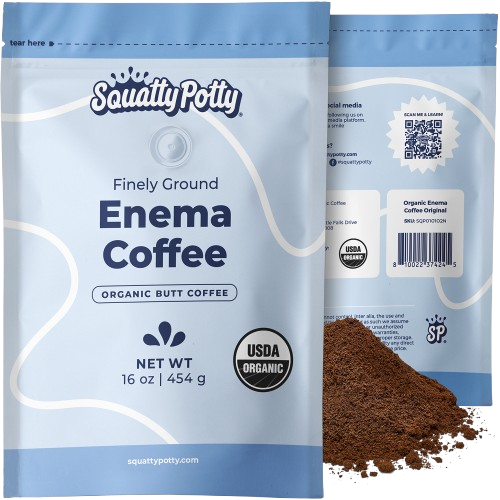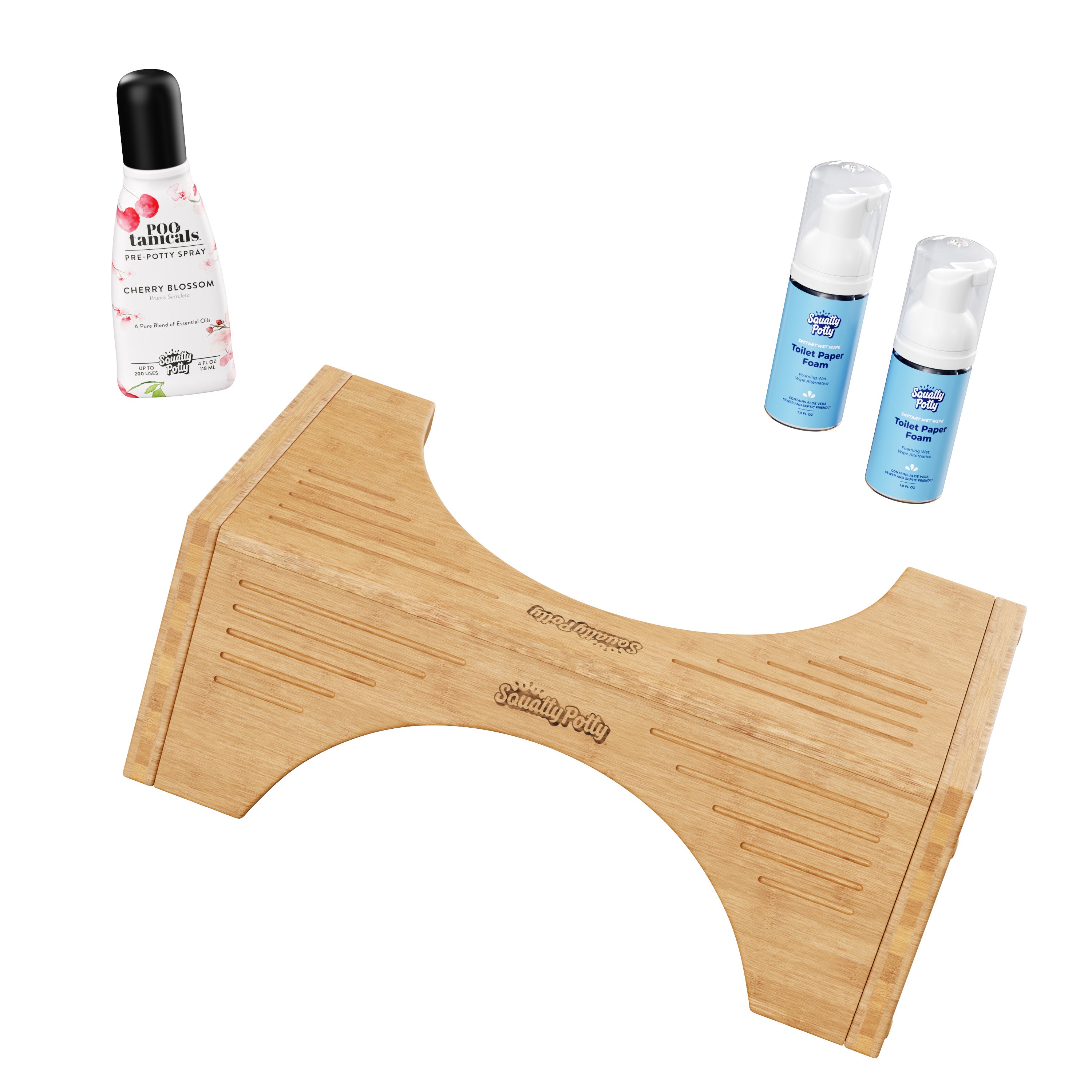Squatty Potty Blog
The real reason you’re disgusted by poop
Poop. Some people find it funny, some find it fascinating, but almost everyone finds it gross. As a species, we’re disgusted by almost everything about it. We don’t like looking at it, we don’t like smelling it, and we certainly don’t enjoy touching it. But, have you ever wondered why we are so grossed out by our own feces?It turns out there are good reasons why humans avoid and detest their waste—reasons beyond basic cleanliness concerns and have implications on our own evolution. Our instincts, culture, and plumbing subtly push us to do our business and walk away. That's why many people use toilet stools for quicker and healthier eliminations. Using a Squatty Potty puts your body and colon at a better angle to push out waste, so you can get in and get out without lingering. The longer you're around your number two before flushing it down, the more likely you'll grow disgusted by the odor. Humans are hardwired to hate poop To understand why we’re sickened by the thought of poo, we have to look at the origins of disgust from an evolutionary standpoint. Psychologists believe disgust evolved to prevent our ancestors from eating spoiled food that might kill them. Darwin hypothesized that early humans revulsed by things like decayed meat, feces, and blood survived to pass on their genes, while those immune to their grossness died off. Poop is waste, after all. There’s a reason why your body wanted to remove it from your system in the first place. While the process isn't gross in itself—it's really just the way your digestive tract works—the physical result is usually pretty nasty. Our excrement is made up of three essential ingredients: water, undigested fiber, and bacteria, much of it potentially harmful. The closer you are to feces, the more you open the door to serious illnesses. Hepatitis, cholera, norovirus, polio, E. coli, tapeworms, and rotavirus are all spread via waste. Our dislike of the smell and consistency of poop likely evolved to keep us from coming into contact with infection and disease. So, the next time you catch a whiff of wafting poo while using your Squatty Potty, thank your sense of disgust for keeping you safe. Poop is gross; pooping is not Our minds are naturally disgusted by the idea of poop, but the shame that comes along with defecating is uniquely human. Mankind is the only species on the planet that passes poop in private. This practice likely originated for sanitary and practical reasons, but over time it’s become coupled with a sense of embarrassment. We pretend it’s a secret. We’re ashamed that someone might know we also expel waste from our bodies. We avoid public bathrooms, hide our Squatty Potties, and turn on fans to mask the sounds and smells. Pooping is a sign that our bodies are healthy and working properly. Yet the thing that comes naturally to every man, woman, and child is often confused as disgusting. No other animal is embarrassed by the act of pooping. Take dogs, for instance—they let nature take its course without any concern for how it might make others feel or whether it might cause them embarrassment or discomfort later on down the line. They just squat, dump, and keep it moving. If you find yourself disgusted by the idea of someone else pooping or even talking about it, you can blame your revulsion on our culture, not nature. There’s nothing inherently nasty about pooping if you're having healthy bowel movements. Good bowel health comes with regular exercise, a balanced diet, and a specially designed toilet stool to help undo the kink in your digestive system. Without all three, the grosser your poops will be. Not sure which toilet stool is right for you? Use our guide to find the stool that best suits you. Find The Right Squatty Potty For You The final turd Our relationship with poop is complicated. It's not just a bodily function. It's an essential part of our existence. And while there is no denying that this substance can be unpleasant to see or smell, nothing is disgusting about having happy, healthy poops (with the help of a Squatty Potty).
Learn more4 Reasons Everyone Should Squat To Poop
You probably don’t give your poop routine much thought these days. You sit, you poop, you flush. If you’re old enough to be reading this, your poop process has already become an unconscious, automatic habit. But, if you learned there was a better way to go number two, would you try it? Most people don't realize there's a healthier, more practical method to take care of business. Squatting. Rather than pooping with your feet flat on the floor, squatting with your feet on a toilet stool puts your body in a natural position, making it easier to let your goods loose.If you’re an American, you might be surprised to learn squatting is a universally accepted pooping practice worldwide. While sitting during defecation is common due to the design of our toilets, many countries use low toilets that allow people to squat over the commode. The easiest way to assume the proper squatting position is by resting your feet on a specially designed toilet stool. A Squatty Potty, scientifically known as a DMPD (Defecation Postural Modification Device) can help you have healthier and happier eliminations. There are hundreds of reasons why squatting with a stool could help your stool, but we’ve whittled the list down to the top 4 advantages. SHOP TOILET STOOLS Here’s how using a Squatty Potty can help you poop better: Squatting reduces strain while pooping Squatting on a toilet stool puts your body and colon at a better angle to push out waste. This improved angle allows for smooth evacuation of feces with minimum straining effort on your end. The less you struggle, the faster and more convenient your defecations will be. When you decrease stress and strain on your body, you’re more likely to avoid bowel issues. After all, strain is a main cause of hemorrhoids. Researchers at Ohio State University found that 90% of people who used a Squatty Potty strained less than those who pooped with their feet on the floor. They also found that 71% of toilet stool users had faster bowel movements. 85% of stool users experienced increased emptiness.Straining caused by sitting on the toilet flat-footed is not healthy. Don’t push it. Effortlessly shoot your shot with a squat. Squatting unkinks your colon You probably don’t feel it, but there’s a slight bend between your colon and anus. When you’re sitting on a toilet, this bend can become kinked, making it harder for waste to pass through. Studies show squatting straightens out this “kinking'' and allows for easier eliminations. When you use an ordinary toilet and sitting position, the rectum does not align with the colon, which means you’ll have to apply more force to expel poop, no matter how healthy you are. We don’t mean to kink shame—the bend in your colon is actually pretty helpful at times. It helps keep poop in before it’s ready for release, saving you from unwanted accidents. When you squat, you realign the colon and straighten the rectum. This alignment sends a signal to your digestive system that you’re ready to go. Squatting removes the clotting if you want to give your poop a smooth ride and straight route out. Using a Squatty Potty is the most effective and popular way to put your body in the correct pooping position. That's because Squatty Potties are specially designed to lift your knees into a squat-like position and conveniently tuck in under the toilet when out of use. Browse Squatty Potty’s collection of designs to put yourself in the right position. Shop stools Squatting to poop helps you feel more empty Squatting while pooping makes it easier to empty your lower colon completely. Remember that study from OSU? It also proved “toilet stoolers” experienced increased bowel emptiness. Bringing up your knees puts you into the proper crouching position and helps you to pass the stool more efficiently, allowing it to flow out with less pushing. Pooping with your hips parallel to the floor, the way most American toilets are designed, makes it harder to have complete evacuation of your bowels. Squatting makes it easier to poop because the colon is tilted forward towards the anus. Toilet stools like the Squatty Potty increase the rectal canal angle from 100 degrees to 120 degrees. The higher the release angle, the more your rectum opens up to deliver the goods. If you want to eliminate exhausting eliminations for good, try popping a squat. Not sure which toilet stool will put your pooper in the proper position? Use our handy guide to find the stool that works for your body type. Find the Right Squatty Potty for You Squatting on the toilet allows your body to relax Humans were naturally designed to squat on the toilet. Propping your feet on a footstool is a more relaxing position for your body to be in when pooping. Beyond being more comfortable, squatting is proven to relax your puborectalis muscle—the muscle that helps hold in your poop. This muscle relaxes when you squat on the toilet, and your poop flows more freely. The more your muscles and sphincters loosen, the more space you make in your rectum, and the easier your evacuations will be. Additionally, when you're in a squatting position, the pressure in your lower colon is higher than when seated or standing. This increased pressure encourages stool to migrate through the colon. Give your anus permission to chill by throwing your feet up on a Squatty Potty and letting gravity do the work. The final turdThe science is in: squatting is the better way to poop. Squatting over the toilet can help eliminate straining and even allow your body to relax. If you’ve ever wished pooping were easier, using a Squatty Potty toilet stool could help.
Learn morePoop in peace: Tips for more relaxing bathroom trips
Finding time to relax is increasingly difficult in our always-on digital world. With productivity tools and entertainment always a click away, slowing down and resting can feel like a thief of precious time. When digital overload leaves you feeling mentally and physically drained, there’s often only one place you can find sanctuary—the bathroom. The toilet is one of the few quiet places you can relax and let your guard down during the day. There’s a reason it’s called the restroom, not the stress-room. No matter how busy things get, you can use your toilet time to let your waste and your worries go. Taking deep breaths, embracing the moment, and assuming the proper position with a Squatty Potty can help you reduce strain and find calm on the can. Here are four ways to reduce stress, find tranquility, and relax the next time you go to the bathroom. Try a breathing exercise. Put your phone away for a minute and try a breathing exercise. Deep breathing is a great way to calm your mind and relax your body. As you ease down onto the bowl, try taking a few breaths in through your nose and out through your mouth. Make sure that you're taking long, deep breaths into your belly. As you breathe in, imagine you’re filling your body with warmth, peace, and calm. When you breathe out, imagine you’re exhaling your body’s stress and tension. A simple breathing exercise can make a big difference in your anxiety levels if you make it part of your regular toilet routine. Find a comfortable squatting position. Propping your feet on a stool is a more natural and relaxing position for your body to be in when pooping. When you squat, your knees are bent, and your hips are lower than your torso. This position makes it easier to poop because the colon is tilted forward towards the anus, making it easier for you to deliver the goods. Squatting using a Squatty Potty can also boost blood flow to the pelvic floor muscles, which helps reduce strain and time on the toilet. Not sure which toilet stool will put you in the best pooping position? Use our guide to find the stool that works for your body type. Find the Right Squatty Potty for You Do a body scan. Use your pooping time as an excuse to release physical tension with a body scan meditation. Here’s how it works: Bring attention to a specific part of your body. Observe the sensations in that area and any thoughts or emotions that accompany it. If you notice pain, breathe into it and visualize the tension leaving your body. When you’re ready, move on to the next body part. Not only will this practice help you relax, but it will help you get to know your body better and better manage pain. Take your time. Don’t rush your toilet time. Let your poop come naturally. It’s natural to want to do your business as quickly as possible to get back on with your day. Pushing, forcing, and straining while pooping can cause health problems and increase discomfort. When you need to go, it’s important to relax your mind and body. Unnecessary straining can cause complications like hemorrhoids and hernias. Stress can also lead to constipation by reducing the blood flow to your digestive tract, making it difficult for waste to move through your body. Avoiding these health complications is easy—just chill! Put your feet up on your Squatty Potty, breathe deeply or enjoy some reading materials, and give your body five minutes to get everything out. The final turd Remember, your bathroom time is your time. No one's watching over your shoulder or judging you for taking up a whole roll of toilet paper. Use it as an opportunity to relax, meditate, rest, and reflect on life. You can read, listen to music, or catch up on podcasts. Do whatever you want. It’s your world! Remember that there’s no right or wrong way to poop. The key is to be comfortable, so you can relax and let nature take its course.By practicing breathing exercises, giving yourself time, and adopting a natural pooping position with a Squatty Potty, you’ll be well on your way to more relaxing trips to the bathroom.
Learn more6 Ways To Detox Your Colon And Poop Better
Most of the time, we can rely on our colon to be a self-cleaning organ. After all, the primary function of the digestive system is to push waste from our bodies. But your colon doesn't exactly evacuate all your waste in one fell swoop or sitting. Even if you’re assuming the proper pooping position with your feet up on a Squatty Potty, some of your fecal matter ends up stuck inside your colon between flushes. This lingering waste may not be ideal if you have constipation or other issues with bowel movements. Luckily, there are ways around these pooping problems. We’ve compiled six easy ways to detoxify and renew your colon for a better bathroom experience. Implementing these solutions and using a toilet stool to unclog your colon can help you have more effortless and satisfying eliminations. Shop Stools 1. Detox by drinking more water The easiest way to detoxify your colon is to drink more water. Water helps keep things moving through your digestive system and prevents constipation symptoms. If your body doesn’t get enough water, your colon may begin to pull water from your stool to maintain hydration. If you’re adequately hydrated, your body has a much easier time flushing waste out. How much water should you drink to help detoxify your gut? Experts say you should aim to drink about half your body weight in ounces of water per day. If you weigh 150 pounds, for example, your goal is to drink 75 ounces of water (a little more than half a gallon or 9 cups) per day. 2. Detox by dieting Diuretic foods and herbs can help the body expel waste and speed up detoxification. What are some examples of diuretic foods? Good question. Diuretic foods include celery, cucumbers, ginger, lemons, peppers, and parsley. Herbs such as dandelion root and parsley seeds have also been known to help alleviate constipation symptoms and keep you regular. Doctors also recommend eating a healthy amount of fiber. Fiber keeps the colon healthy by reducing constipation symptoms and fighting diverticulosis, the accumulation of tiny bulging sacs on the wall of the colon. Fiber comes from fruits, vegetables, and whole grains. Experts recommend eating about 25 grams of fiber daily to keep things moving properly. 3. Detoxify through exercise You already know that exercise is good for your overall health. But did you know it can also help detox your colon? Any activity that gets you moving and sweating will help keep your colon functioning properly. Whether walking around the block, taking a jog, or going for a hike, exercise has been proven to improve circulation and blood flow through your digestive tract, allowing your colon to perform at optimal levels. As long as you keep moving and stay active every day, you’ll be able to have cleaner-feeling stools faster than ever before. 4. Change your pooping posture How you sit on the toilet can significantly affect how well your colon expels waste. Most toilets are designed for sitting, not squatting. The American toilet design can cause uncomfortable shifting or twisting of your body as you try to get properly aligned over the bowl. Squatting using a toilet stool helps you avoid straining while pooping, so you can move your business out of your colon without much effort on your end. The squatting position offers several additional health benefits, such as improved blood flow through lower extremities and helping prevent stagnation between organs within our abdominal cavity. Not sure which toilet stool is suitable for you? Use our guide to find the stool that best suits you. Find the Right Squatty Potty for You 5. Take probiotics to improve gut health Adding a daily probiotic to your diet can help cleanse your colon and detoxify your gut. Probiotics are good bacteria that live in your gut and help keep it healthy. Probiotic foods or supplements won't only help your digestive system function more effectively, but they've also been shown to boost your immune system and improve brain function. When it comes to supplements, you might need to shop around until you find the right one that works for your gut composition. If you want to add probiotics to your diet naturally, fermented foods like sauerkraut, kimchi, or miso contain natural probiotic bacteria. 6. Look into a colon cleanse Colonic irrigation, also known as a colonic or colon hydrotherapy, is an alternative medical treatment that involves flushing out your entire large intestine with water. Proponents of colon cleansing believe that colon cleansing improves health by removing toxins, boosting your energy, and enhancing your immune system. However, there's no concrete medical evidence that colon cleansing produces these effects. In most cases, if you’re maintaining a healthy lifestyle and pooping in the right position, your digestive system and bowel already efficiently eliminate waste material and bacteria from your body without the help of a cleanse. Check with your medical provider to see if this procedure is right for you. The final turd So there you have it, six different ways to detox your colon and improve your health. By drinking more water, eating a healthy diet, and adopting a natural squatting position with a Squatty Potty, you’ll be well on your way to flushing your colon of toxins and enjoying a healthier gut.
Learn moreWhy Does Coffee Make You Poop?
We’ve all been there. You take a sip of your morning coffee, and suddenly you feel the urge, the urge to purge. The question is: Why does coffee make us poop? If you’re curious about why a cup of joe makes you go, stick around and we’ll explain how coffee helps you move your bowels. Drinking coffee, eating a healthy diet, and using a toilet stool to unkink your colon have been proven to help produce better bowel movements. But why exactly does coffee—the magical elixir that improves everything from focus to mood—help us poop? Let’s dig into the details. Caffeine is key When you drink coffee, you flood your body with caffeine. A stimulant, caffeine doesn’t only wake up your mind, but it jump-starts your digestive system and prompts the bowels to release stool. Caffeine sends a signal to your stomach lining to release a hormone called gastrin. This hormone stimulates the contraction of smooth muscles in your digestive tract that move food toward your bowels. The faster these waves of muscle contractions work, the quicker food moves through your body and the more water is absorbed from your fecal matter, resulting in softer stools that are easier to pass. For some, a hit of caffeine can lead to a trip to the bathroom in just a few minutes. It's also one of the reasons people will do coffee enemas. Coffee keeps the gut healthy Much like assuming a proper pooping pose with a Squatty Potty, coffee keeps your digestive system running smoothly. Coffee is a complex drink. It contains more than 1,000 chemical compounds, many of which are good for the gut. Antioxidants such as polyphenols and minerals like magnesium can help keep you regular and prevent constipation. The caffeine in coffee also improves “good” bacteria counts in your digestive system by increasing bile acid production. This good bacteria, also known as probiotic bacteria, helps break down fat for digestion and absorption of nutrients into the body. Caffeine also boosts antioxidant levels, which reduce inflammation throughout the body and improve overall digestive health. Should you drink coffee to make you poop? If you find that coffee helps you poop, go for it! Studies show coffee can help you make and take better bowel movements, but you’ll need more than just java alone to stay regular. Good bowel health comes with regular exercise, a healthy diet, and using a specially designed toilet stool to help undo the kink in your digestive system. Not sure which toilet stool is right for you? Use our guide to find the stool that best suits you. Choose The Right Squatty Potty For You Like everything, doctors recommend drinking coffee in moderation. A few cups a day can help you poop, but drinking too many caffeinated beverages can also lead to diarrhea and constipation. Keeping your caffeine intake less than 400mg (or four cups of coffee) per day will help avoid stomach issues caused by overconsumption. The final turd A daily brew can help you poo. Coffee acts as a natural laxative, helping move food and waste through your digestive tract quicker and easier. In addition to giving you an energy boost to get things moving, coffee is also rich in antioxidants proven to boost gut health. Drinking less than four cups of coffee per day, assuming a natural squatting position with a Squatty Potty, and maintaining a healthy diet are all effective ways to make 'going' easier!
Learn more6 Ways To Make Your Poop Smell Better
Sometimes taking a good bathroom break can leave you in a state of poo-phoria, especially when you use a Squatty Potty to position your body in a comfy squat. But as good as it feels, it can smell terrible—which is why, no matter where you are, you want to make sure the odor of your ordure is not overpowering. To help you make and take more pleasant smelling poops, we’ve compiled a list of ways to make your waste smell wonderful. Avoid strong-smelling foods If you’ve heard it once, you’ve heard it a thousand times: You are what you eat. Your poop is also, quite literally, what you eat. If you eat something with a strong smell, your poop will often retain that same odor. With that in mind, you'll want to steer clear of foods that are known for having a strong stench. If you’re worried about the essence of your excrement, you should try to avoid strong-smelling fruits and vegetables like onions, garlic, and cauliflower, or meats like fish or certain cuts of beef. Also note that the more you cook or fry these foods, the worse they’ll smell on the way out. Squat to get it all out at once The less you visit your bathroom, the less likely you'll be leaving behind bathroom odors. Squatting to eliminate is clinically proven to increase bowel emptiness which means you won't be going back for round 2.Using a specially designed toilet stool, helps undo the kink in your digestive system without any extra effort on your end. Not sure which toilet stool is right for you? Use our guide to find the stool that best suits you. Choose The Right Squatty Potty For You Keep your bacteria in check with probiotics In addition to assuming the proper pooping pose with a Squatty Potty, probiotics have also been proven to help regulate gut bacteria and keep your digestive system running smoothly. They promote good bacteria in your gut, which can help cut down on nasty smelling gas and waste. Probiotics don’t only help you take better smelling movements, they can also help with a range of other health issues like diarrhea, constipation and allergies. Check your medications If you’re taking regular medication, it’s probably for good reason. That said, medications could also be the culprit of your nasty-smelling stool. If you’re concerned about the scent of your scat, ask your doctor or pharmacist if your meds could be causing the odor. The conversation could lead to important conclusions about what the medicine is doing inside your body. Medications, for example, can sometimes cause constipation and diarrhea—both of which can smell unpleasant. In addition to odor, medications may also change your bowel habits, stool color and shape. So when looking for solutions to improve the smell of your poop, make sure to talk to your doctor first about any medication changes before trying any home remedies. Poop Regularly The longer your waste has to sit in your stomach, the worse it often smells. If you poop less than once every three days, it's easy for your stool to become hard and dry. This can lead to stinky gas that smells like sulfur or rotten eggs. Pooping more often is important for keeping things looking and smelling good down there. To help you avoid constipation, we’ve compiled a list of simple tips and tricks to get you unstuck when you’re in a jam. Simple tricks to avoid constipation Drink more coffee If you're dealing with digestive problems that make your poop smell bad, the solution could be as simple as drinking more coffee. Coffee is a natural stimulant known to increase the frequency of bowel movement and reduce constipation or bloating. Drinking coffee can help eliminate bad bacteria that leads to foul-smelling fecal matter. The final turd When it comes to changing the smell of your poop, it’s mind over (fecal) matter. Poop will always have a stench, but using these simple tips and tricks to take your waste from nasty to normal in the flush of a toilet. Avoid foul-smelling foods, tracking your gut health, and assuming a squatting position with a Squatty Potty are all effective ways to keep your bathroom smelling pleasant.
Learn moreWhat Your Poop is Trying to Tell You About Your Health
Your poop is talking to you. Not literally, of course—but every time you make a deposit at the ol’ porcelain bank, your body is trying to tell you something about your health. It might not be pretty, but feasting your eyes on your feces view can offer a wealth of information about the wellness of your digestive system. It can tell us how well you are eating, how much stress you’ve been feeling, and even what your hormone balance is like. Here are a few things you can learn by taking a peek at your poop.What the color of your poo is trying to tell you The color of your poop can give you the scoop on your internal workings. While a chocolatey brown poop indicates a healthy gut, anything different can indicate anything from poor diet to infection. Bright red stool is indicative of hemorrhoids or anal fissures, which can be irritating, but are relatively harmless. Yellow or green stool may signify gallbladder trouble, an intestinal infection, or a liver issue such as hepatitis or cirrhosis. Dark or black coloring may indicate ulcers, polyps, or internal bleeding. These issues could be potentially more serious. White specks could mean you have a parasitic infection…which, yikes. If you look down and see something colorful in your bowl, it could be a sign to contact your doctor. What the size of your poo is trying to tell you A medium, hot dog-shaped bowel movement means your body was able to successfully remove nutrients and water from your food. If your stools lack these characteristics, pay close attention to them and visit your doctor if they persist for long periods of time. If your poops are small or pellet-like, it’s a strong indicator that you’re constipated. If you're taking massive dumps, it could be a sign of excess fat in your intestines from poor diet or illness. And if your poop is wet and watery? You’re likely dehydrated, have a bacterial infection, or your hormones are out of whack. We spent a full post discussing why the shape of your bowel movement matters, so head over there if you want to learn more about what the shape and size of your poop really means. What the smell of your poo is trying to tell you Poop smells. That’s just the nature of discharging bodily waste. But, if the smell of your poop has recently changed for the worse or is excessively foul, it could be a sign of malabsorption of nutrients or bacterial overgrowth. Many different diseases, disorders, and conditions can also lead to distressingly nasty smelling stool. Identifying and treating the underlying cause of the odor early is important to minimize any potential complications or damage to your digestive system.What else can my poop tell me about my health? When you look down into your toilet and see anything but a brown, sausage-like turd at the bottom of the bowl, take note. If your stool is floating it could mean fatty acids are not being absorbed into the gut. Greasy stool could indicate pancreatic insufficiency. Undigested food particles can sometimes be found in healthy stool, but if you’re consistently seeing bits of last night's dinner in the bowl, you could have an autoimmune disorder of the small intestine caused by intolerance to food, a digestive enzyme deficiency, or allergies. Long story short, if you see something abnormal, it’s probably a sign that isn't working quite right in your digestive system.Our bowel movements can provide a wide range of information about our health. So, before you rush to flush, study your stool and see what it has to say.
Learn moreHow Long Should It Take Me to Poop?
Everybody poops. But does everybody poop in the same amount of time? Hardly. Some people poop in the time it takes to read this sentence. Others can read this post in full...
Learn moreFive Simple Tricks to Avoid Constipation
Taking a hearty, healthy poop can be one of life’s great pleasures. No matter the consistency, letting one loose is a solid way to feel like you accomplished something during your day. On the other hand, one of life’s great miseries is not being able to shake one free. You’ve probably been there. You feel the urge. You head to the bathroom. You assume position on your trusty toilet and then—nothing. A daunting realization slowly creeps into your mind. You’re constipated. If you’ve ever suffered from constipation, then you know how uncomfortable and painful it can be. While there isn’t enough clinical data to prove the Squatty Potty can cure constipation, it can ease the strain of pooping by 90%. To help you on the toilet, we’ve compiled a list of simple tips and tricks to get you unstuck when you’re in a jam. 1. Fuel Your Poop Chute Properly The easiest way to avoid constipation is to simply eat more fiber. Not sure what fiber is exactly? It’s the portion of your food that your body cannot digest. Eating fiber creates a healthy, but indigestible mass that passes through your digestive system, helping the body eliminate waste and keeping things moving smoothly along. Eat more high-fiber foods like beans, fruit, vegetables, and whole grains to help restore regularity. 2. The More You Move, The More You Poop Constipation is often caused by our modern lifestyle. We sit in traffic, we sit at our desks, and we sit on the couch playing Wordle. We don't move around enough, which is why so many of us suffer from constipation. Gentle exercise is your best friend when it comes to keeping things moving through your digestive tract. Regular activity keeps your body busy and gives your internal plumbing less time to absorb water, keeping your poop nice and slick on the way out. 3. Let’s Get Regular Finding a stable poop routine keeps the intestines clean. Constipation is defined as having three bowel movements or less per week. Training your body to poop once per day can provide serious constipation relief. Here’s a tried and true poopus-operandi: Start your day by drinking a cup of water and coffee each morning. Ingesting fluids right when you wake up rehydrates your body and helps your digestive system absorb essential vitamins and minerals that keep everything running smoothly. 4. Listen to Your Fart When you feel the urge to purge, it is probably best to heed it. When you put off pooping for a more convenient time, you’re sending signals to your colon to stop pushing and start storing. The longer you wait, the harder it can be to get those digestive juices flowing and those internal muscles pumping. To avoid constipation, listen to your body as soon as it says it’s time to go. 5. Don’t Let Stress Get You Down in the Dumps The more mental stress you feel, the higher the physical toll on your body. Anxiety and stress not only drive some of the bad habits that cause constipation (poor diet, lack of exercise, etc.), but they can also literally affect the function of your sphincter. Finding solace in this day and age is easier said than done, but activities like meditation, yoga, or even taking a short walk have been proven to help put the mind at ease. The smoother your internal thoughts, the smoother your external poos. If you’ve experienced constipation, you’re not alone. In fact, it’s estimated one in five Americans suffers from chronic constipation. Next time you’re feeling stuck, avoid becoming one of them by using these simple tips to relieve your constipation symptoms.
Learn more

